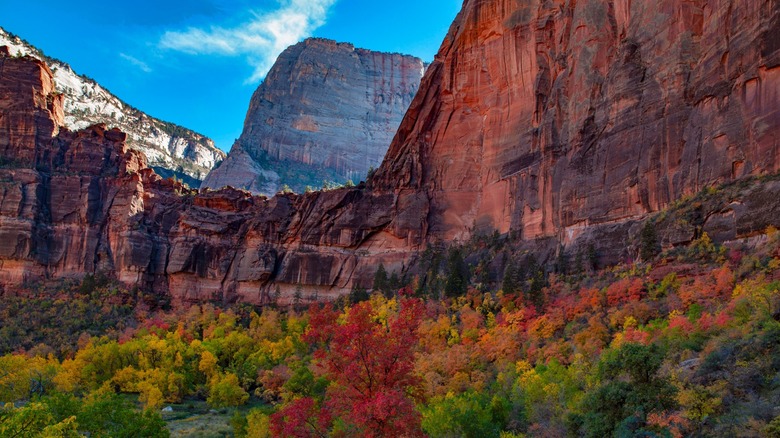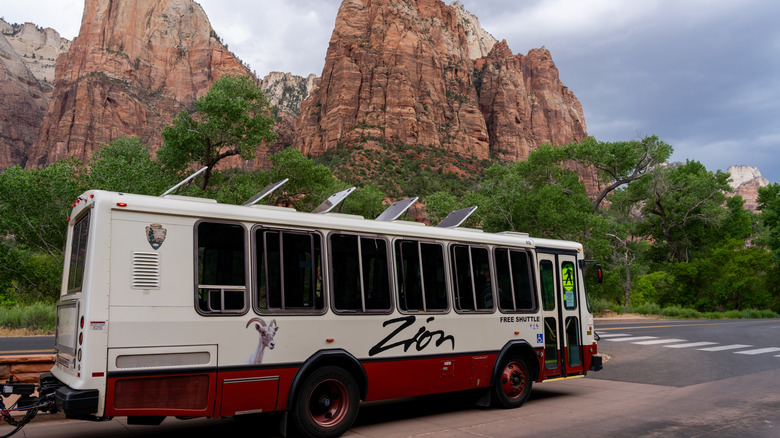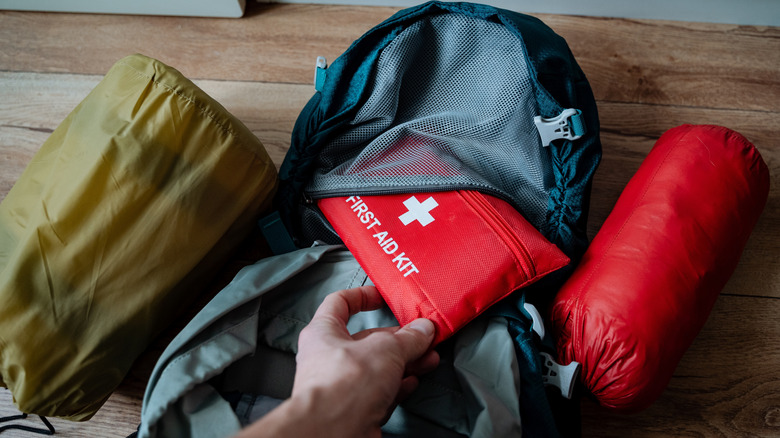This Incredible National Park In Utah Is Full Of Scenic Cliffs, Canyons, And Hiking Trails
Beauty is in the eye of the beholder. However, from its gorgeous snow-covered Wasatch Mountains up north to one of the prettiest man-made lakes in the nation down south, Utah makes a strong case for being one of the most beautiful states in the country. And tucked in the state's southwestern corner lies one of Utah's five national parks: Zion National Park, an outdoor paradise where nature's canvas of towering sandstone canyons and cliffs is dotted with over 800 species of plants.
The park's modern history is nearly as fascinating as its geology. Mormon pioneers trekked down to southwestern Utah in the 1850s and began to settle around what they called Zion Canyon, directly referencing the struggles and perseverance Mormons faced to establish the proposed state of Deseret. For thousands of years prior, the Southern Paiutes and the Ancestral Puebloan tribes had settled and traversed through the region, calling the area Mukuntuweap, or "straight canyon." Many of the Paiutes soon succumbed to diseases or left the area, though the Native name stuck when President Taft, unknowingly at the request of Brigham Young, the former leader of the Mormon Church, dedicated Mukuntuweap National Monument in 1909. However, in 1918, the director of the National Park Service, Horace Albright, changed the park's official name to Zion National Monument to appease the locals.
The park's primary entrance at the mouth of Zion Canyon is about one hour east of St. George, just outside of Springdale. For travelers flying in, your most convenient option is St. George Airport (SGU), served by Delta, United, and American. Meanwhile, the uncrowded "other" entrance of Zion, at Kolob Canyons, is located right off of I-15, which is just over 30 minutes north of St. George and roughly 20 minutes south of Cedar City, Utah.
Easy access to Zion's scenic cliffs and canyons
In recent years, millions of travelers have explored Zion's 250-million-year-old formations and scenic cliffs. This includes hitting up the trails leading to Angels Landing, the Temple of Sinawava, The Narrows, and the Court of the Patriarchs. In addition to these world-renowned hiking trails, the park also has incredible family-friendly and accessible hikes for all. For example, the Lower Emerald Pools Trail is a quintessential Zion experience, combining water in the desert and gorgeous canyon views with an easy 1.4-mile trail.
Another option is the wheelchair-friendly Pa'rus Trail — taken from the Paiute word for "bubbling water" — which is considered one of the best walks in the park to experience a breathtaking Utah sunset or see the stars at night. During the day, you will be treated to gorgeous views of The Watchman, Bridge Mountain, the West Temple, and Bee Hive as you move toward the Canyon Junction. Once you reach the end, turn and head back, or catch a shuttle to the Visitors Center.
Whether you're on the way to a breathtaking hike up Zion Canyon or just want to relax in the comfort of some air conditioning on a hot summer day, make sure to leave your car at the hotel and hop on one of the free shuttle buses departing from Springdale. Running every few minutes throughout the day from mid-May to November 30 and during the holiday season in December, the shuttle will take you on a postcard-worthy journey along the Zion Canyon Scenic Drive. Just make sure you're there a few minutes early if you're planning to catch the last shuttle bus. Otherwise, you might have to walk back at night if there is no space on board.
Challenging hikes up Zion Canyon
The dramatic landscapes across Zion National Park's 232 square mile area rise and fall nearly a mile in elevation. Hikers looking to experience these gains alongside truly magnificent views shouldn't miss tackling Angels Landing Trail. Accessible from the Grotto, the trek is considered one of the most dangerous hikes in America due to its narrow footpaths and technical maneuvers, leaving a small margin for error. Unlike other trails at Zion, Angels Landing requires all hikers to have a permit, which they must apply for through a lottery system. Entry into the lottery costs $6 and doesn't mean you're guaranteed a spot. According to the National Park Service, the average success rate is about 50%. However, during peak season, it can drop to less than 10%.
If you're unable to get a permit to hike Angels Landing, or if you're concerned about the dangerous cliffside footpaths, opt for Scout Lookout instead, which shares part of the same trail. This gorgeous 3.5-mile hike is paved, though still very challenging, and requires visitors to climb a whopping 1,000 feet, sometimes at a 43% grade. Crossing the Virgin River and passing through shady Refrigerator Canyon, plan on setting off early in order to avoid the midday heat. In addition to the rock formations, you may see mule deer, and possibly an endangered California condor on the cliffs.
On a hot 100-degree Fahrenheit summer day, however, few outdoor experiences can match a hike near or through The Narrows. Here, you'll trek through the Virgin River between towering canyon walls. To reach the trailhead, simply hop on the shuttle and head to the last stop before following the route to the Temple of Sinawava, and ford the Virgin River.
Tips for enjoying your outdoor experience at Zion National Park
Whether you're powering up for your hike or recharging after tackling a trail, Springdale — located at the mouth of Zion National Park where nature and civilization meet — has plenty of shops, eateries, and outdoor thrills for you to enjoy. Once in town, you'll find places to shop for last-minute gear and can even hire a local guide for your adventure.
Speaking of last-minute purchases, it's essential to make sure that you're well-equipped to deal with changing weather conditions before heading out. During the summer, from July to September, monsoon-like torrential rains target the region, and flash floods can occur without warning. Whether you're planning to traverse The Narrows or navigate support chains to Angels Landing, be sure to check the weather and the National Oceanic and Atmospheric Administration flash flood warning forecast before hitting the trail. It's also a good idea to wear a sturdy pair of boots no matter the season. Additionally, although rare at these elevations, altitude sickness can also be a real threat. If you start to feel lightheaded, queasy, or weak, take a breather and turn around. Don't jeopardize your safety for the sake of reaching the summit, especially on Angels Landing.
Your biggest concern, however, especially during the summer, should be staying hydrated to prevent heatstroke. To avoid complications, always pre-hydrate, bring a large water bottle, and carry electrolyte packets to replace salts and sugars lost while you sweat. Make sure you also keep a few spares handy — with thousands of visitors at the park during the summer months, someone else may run into trouble. Finally, make sure to always follow Leave No Trace principles and pack up all of your litter so future generations can share in the same incredible experiences.



